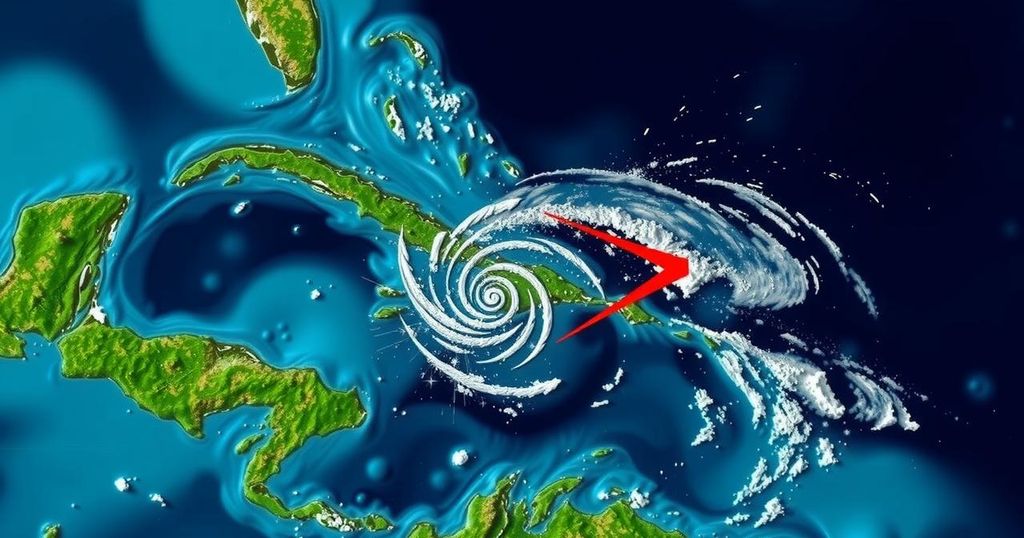Tropical Storm Oscar Advances Towards the Bahamas After Impacting Cuba

Tropical Storm Oscar, which made landfall as a hurricane in Cuba, continued its path toward the Bahamas, resulting in at least six fatalities due to heavy rains. The storm was noted for being the smallest hurricane on record, with unexpected intensification that caught meteorologists off guard. The Atlantic hurricane season has been predicted to be active this year, with Oscar being the 15th named storm.
Tropical Storm Oscar progressed towards the Bahamas following its landfall in Cuba as a Category 1 hurricane. The storm resulted in the tragic loss of at least six lives due to severe rainfall on an island already grappling with a significant power outage. As of Tuesday morning, Oscar was situated approximately 45 miles (75 kilometers) south-southeast of Long Island, Bahamas, boasting sustained winds of 40 mph (65 kph) while moving in a north-northeast direction at 12 mph (19 kph), as reported by the National Hurricane Center based in Miami. Currently, it is stated that “Oscar is at best barely a tropical storm at this time,” according to the National Hurricane Center. The storm is anticipated to bring heavy precipitation, with rainfall amounts reaching up to 5 inches (13 centimeters) across the southeastern Bahamas and potentially peaking at 8 inches (20 centimeters) in localized areas. Consequently, a tropical storm warning has been issued for the central and southeastern regions of the Bahamas. Remarkably, Oscar set a record as the smallest documented hurricane, with a wind field measuring merely 6 miles (10 kilometers) in diameter. Its formation took many by surprise as it initially made landfall on Grand Inagua Island in the Bahamas and subsequently impacted eastern Cuba over the course of the weekend. Notably, hurricane specialist Michael Lowry remarked, “It’s not often we see a colossal failure in hurricane forecasting,” highlighting the unexpected nature of Oscar’s rapid intensification into a hurricane, a scenario that forecasting models had not predicted. In Cuba, Oscar deposited substantial rainfall, measuring at least 15 inches (38 centimeters) in certain regions and prompted warnings of severe flooding and the heightened risk of landslides, particularly in Guantánamo where the six fatalities occurred. This storm struck at a time when Cuba was still recovering from an extensive blackout that ignited a series of small protests and incited stern governmental warnings against further unrest. Oscar has thereby become the 15th named storm and the 10th hurricane of the current Atlantic hurricane season, which spans from June 1 to November 30. The National Oceanic and Atmospheric Administration (NOAA) had earlier forecasted an above-average hurricane season for the Atlantic, attributing this prediction to historically elevated ocean temperatures and estimating a total of 17 to 25 named storms, with 4 to 7 reaching major hurricane status of Category 3 or higher. At the same time, a separate weather event was occurring, as Tropical Storm Kristy was observed churning over the open waters of the Pacific Ocean, located 375 miles (605 kilometers) west-southwest of Acapulco, Mexico. This storm was recorded having maximum sustained winds of 50 mph (85 kph) while advancing in a west-northwest direction at a speed of 15 mph (24 kph), and it was forecasted to strengthen into a hurricane by Tuesday evening.
This article addresses the developments surrounding Tropical Storm Oscar, which transitioned into a hurricane before impacting Cuba and approaching the Bahamas. It emphasizes the storm’s intensity, the resulting fatalities and damage it caused in Cuba amid ongoing power issues, and the broader implications for the hurricane season overall. It also touches upon Tropical Storm Kristy occurring concurrently in the Pacific, providing context to ongoing tropical weather activity.
In conclusion, Tropical Storm Oscar’s trajectory toward the Bahamas represents yet another significant weather event in an active Atlantic hurricane season, emphasizing the unpredictability of hurricane developments. Its impact on Cuba, notably the tragic loss of life, underscores the necessity for preparedness and resilience in the face of increasingly erratic weather patterns. The concurrent activity of Tropical Storm Kristy further illustrates the scale of challenges faced during this time of year.
Original Source: www.usnews.com






